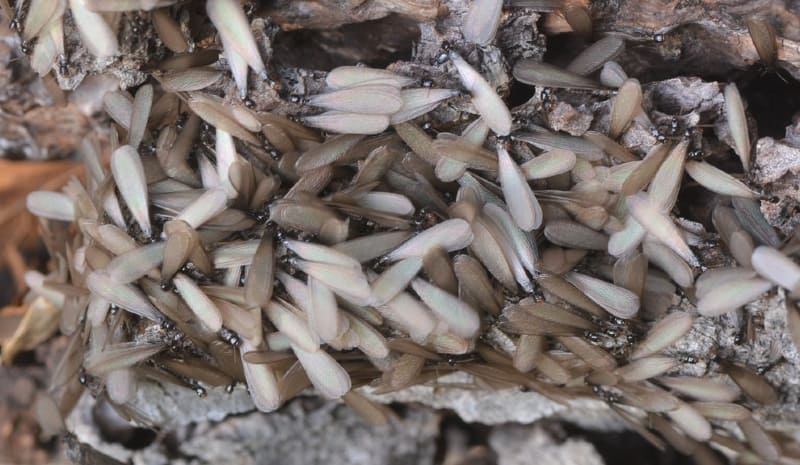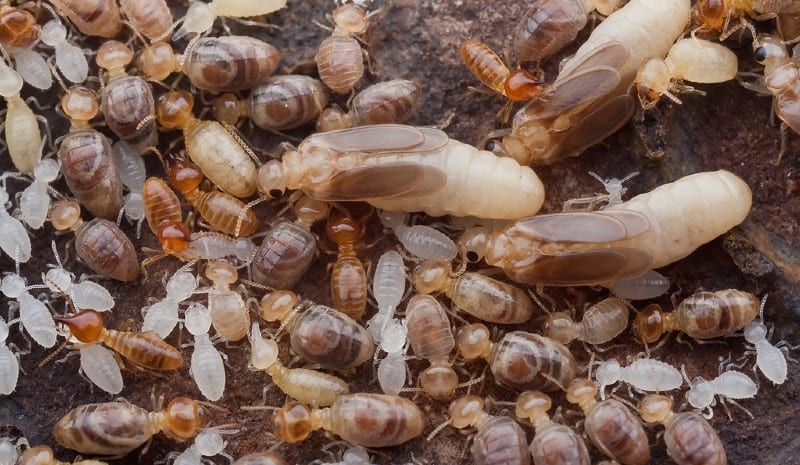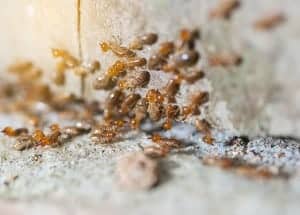What are Subterranean Termites?

Subterranean termites are a type of termite that lives in the soil, feeding on wood and other cellulose-containing materials. They are one of the most destructive pests, capable of causing significant damage to homes and other structures. These termites are social insects that live in colonies typically consisting of thousands to several million individuals. Like other termites, the subterranean termites have distinct physical characteristics that differentiate them from other insects.
Understanding the behavior and reproductive processes of subterranean termites is vital in preventing and eliminating their destructive impact on structures. These termites have a distinct reproductive process known as nuptial flight, where winged termites emerge from their nests to mate and establish new colonies.
Establishing a colony typically involves the queen termite, who can lay thousands of eggs per day, and the king termite. The king and queen lead the colony and are responsible for laying eggs and ensuring the survival of the colony.
Subterranean termites are incredibly destructive insects that can cause significant financial and structural damage to homes and other properties. Early detection and proper control methods, such as regular monitoring and preventative measures, are necessary to prevent their activity and protect your property from damage caused by these pests.
The Swarm’s Purpose
A termite swarm is the reproductive event for subterranean termites, where winged males and females leave their nest in order to mate and establish new colonies. The purpose of the swarm is to allow the termites to reproduce and expand their territory. During this mating ritual, the King and Queen will mate while in flight, and then return to the ground to start their new colony.
It is essential to note that not all termites swarm, only the reproductive males and females take part in the swarm. The swarm is also dependent on a variety of factors such as the temperature, wind, and humidity levels. In most cases, the swarm happens during the spring and summer months, when conditions are favorable for the termites.
While the swarm is a natural occurrence, it can also be a sign of a termite infestation. If you see a swarm in or around your home, it is important to take immediate action to prevent the termites from causing any structural damage. Termites are notorious for their ability to cause extensive damage, and early detection is necessary to prevent further damage to your property.
Reproductive Processes
The mating habits of subterranean termites involve a complex reproductive process that ensures the survival and expansion of their colonies. Understanding how these insects mate and establish colonies is vital in maintaining termite control. In this section, we’ll delve into the fascinating and somewhat perplexing reproductive processes of these underground dwellers. So, let’s dive in and explore the intricacies of termite reproduction.
Nuptial Flight
During the process of nuptial flight, subterranean termites take to the air to mate with other winged termites. This is a crucial part of their reproductive process, as it allows them to expand their colonies and increase their chances of survival. Here are some facts about nuptial flight that you need to know:
- Timing is crucial: Nuptial flight usually takes place during the spring and early summer months, when weather conditions are optimal for the termites to take to the air. The exact timing of the flight depends on a number of factors, such as temperature, humidity, and the phase of the moon.
- Winged termites are highly vulnerable: During the flight, both male and female winged termites are highly vulnerable to predators, such as birds and other insects. Many of them will not survive the journey.
- Pairing up: Once the termites reach the mating area, they pair up and engage in a courtship ritual. Once they have mated, they shed their wings and begin the process of establishing a new colony.
- Size of the swarm: The size of the swarm can vary greatly, ranging from just a few hundred termites to several thousand. Larger swarms usually have a higher chance of success in establishing a new colony.
It is important to note that while nuptial flight is a natural and important part of the termite’s life cycle, it can also be a nuisance for homeowners. It is during this time that termites are most likely to be seen in and around homes, and it is crucial to take preventative measures to ensure that they do not establish a new colony on your property.
Establishing a Colony

After their nuptial flight, the male and female subterranean termites pair up and search for a suitable location to start a new colony. The termites must find a moist and nutrient-rich environment that allows for the growth of a fungal food source, which is necessary for the young termites to survive.
Location: Once a location is found, the male and female termites will shed their wings and seal themselves in a chamber made of saliva and feces. This chamber will serve as the nucleus of the new colony.
Egg laying: The female termite will begin laying eggs and caring for the first brood while the male termite provides protection and helps to expand the colony. As the termite colony grows, it will become more complex and organized with distinct castes, including workers, soldiers and reproductive termites.
Fungal growth: In addition to caring for the young termites, the workers will also cultivate the fungal food source by-ingesting cellulose from decaying wood and secreting it onto the fungal garden. The fungus breaks down the cellulose into simpler compounds that the termites can digest, providing the necessary nutrients for the colony.
Reproduction: The reproductive termites will eventually mature and leave the colony, beginning the process all over again in a new location. It’s important to note that subterranean termites can establish multiple satellite colonies, making control and prevention crucial for homeowners and property owners.
Maintaining Termite Control
Ensuring that your home stays termite-free is a crucial aspect of maintaining a safe and secure living environment. Termites can cause significant damage to buildings, resulting in costly repairs and posing potential risks to your family’s health and wellbeing. To prevent such damage and reduce the risk of termite infestation, it’s important to understand the various steps involved in termite control. From early detection to professional treatment options, let’s explore the measures you can take to keep these subterranean creatures at bay.
Importance of Early Detection
Identifying a termite infestation early on is crucial in maintaining termite control. It is important to have regular inspections of your home, particularly if you live in an area where subterranean termites are prevalent. According to research, termites cause an estimated $5 billion worth of damage annually in the US alone.
If left undetected, the damage from a termite infestation can be extensive. Termites can consume wood at a rapid pace, potentially destroying the structural integrity of your home. This can lead to safety hazards and costly repairs.
Table: Signs of a Termite Infestation
| Signs of a Termite Infestation | Description |
|---|---|
| Mud Tubes | Small, soil-colored tubes that termites use to travel from their colony to a food source |
| Swarmers | Winged termites that emerge from their colony to mate and establish new colonies |
| Wood Damage | Hollowed or damaged wood, often with a honeycomb-like appearance |
| Frass | Termite droppings that resemble sawdust or sand |
Early detection of a termite infestation can prevent extensive and costly damage to your home. If you notice any signs of an infestation, it is important to act quickly. Contact a professional termite control service to inspect your home and recommend preventative measures.
Preventative measures can include regular termite inspections and treatment plans. By taking steps to prevent a termite infestation, you can save yourself the headache and expense of dealing with a full-blown infestation. Keep your home safe and healthy by prioritizing early detection and termite control.
Preventative Measures
Preventative Measures are an important way to protect against subterranean termite infestation. Taking the proper preventative measures can reduce the chance of termite damage. Here are some effective preventative measures:
| Preventative Measures | Explanation |
|---|---|
| Elimination of Moisture | Subterranean termites thrive in moist environments. Eliminating moisture sources, such as leaky pipes or excess condensation, can reduce the risk of infestation. |
| Removal of Wood Debris | Wooden debris, such as piles of firewood or old furniture, can attract subterranean termites. Removing these sources of food can deter termites from entering the area. |
| Sealing Cracks and Gaps | Subterranean termites can enter through small cracks and gaps in the home’s foundation. Sealing any cracks and gaps can help prevent termites from entering. |
| Clean Gutters and Downspouts | Gutters and downspouts that are clogged with debris can cause water to accumulate, which can attract subterranean termites. Keeping these areas clean can reduce the risk of infestation. |
| Regular Inspections | Regular inspections by a pest control professional can help detect any signs of termite activity early, which can prevent major damage to the home. |
By taking these effective preventative measures, homeowners can reduce the risk of subterranean termite infestation and protect their homes from expensive damage.
Conclusion
After learning more about the mating habits of subterranean termites, it’s clear that these pests are more complicated than many people realize. Their swarming behavior, reproductive processes, and ability to cause widespread damage make them a formidable opponent for any homeowner or pest control specialist.
One of the most important things to remember is that early detection is key when it comes to termite control. Being able to identify the signs of a termite infestation before it gets out of hand can save you time, money, and frustration in the long run.
Preventative measures can also go a long way in keeping termites at bay. Regularly inspecting your home for moisture issues and ensuring that wood is not in contact with soil can make it less attractive to termites. Additionally, using termite-resistant materials in construction and installing physical barriers like mesh screens can help prevent termites from gaining access to your home.
If you do find yourself dealing with a termite infestation, it’s important to seek professional treatment options as soon as possible. DIY treatments are often ineffective and can even make the problem worse. Professionals have the knowledge and expertise to effectively eradicate the colony and prevent future infestations.
In conclusion, while subterranean termites may seem like just another pest, their complex mating habits and ability to cause extensive damage make them a force to be reckoned with. By staying vigilant, taking preventative measures, and seeking professional help when necessary, you can keep these pests at bay and protect your home for years to come.
Frequently Asked Questions
How quickly can subterranean termite colonies establish?
Subterranean termite colonies can establish in as little as two years.
Can subterranean termites infest a concrete foundation?
Yes, subterranean termites can infest concrete foundations, as they are able to build mud tubes on the surface of concrete.
Do subterranean termite swarms occur at the same time every year?
No, the timing of subterranean termite swarms can vary depending on geographical location and climate conditions.
Can I prevent subterranean termite infestations without professional treatment?
While it may be possible to prevent subterranean termite infestations with DIY methods, professional treatment is recommended for effective and long-lasting control.
Can subterranean termites cause damage to trees?
Yes, subterranean termites can cause damage to trees by feeding on the roots and causing them to weaken and potentially topple over.
How does temperature impact subterranean termite activity?
Subterranean termite activity tends to increase in warmer temperatures, typically around 70-90 degrees Fahrenheit.
Can subterranean termites be beneficial to the environment?
While subterranean termites are known for causing damage to structures, they can be beneficial to the environment by breaking down dead plant material and enriching soil.
How long do subterranean termite swarms typically last?
Subterranean termite swarms typically only last for around 30 minutes to an hour.
Can subterranean termite colonies have multiple queens?
Yes, subterranean termite colonies can have multiple queens, which can increase their reproductive output and colony size.
Are there any natural predators of subterranean termites?
Some natural predators of subterranean termites include ants, birds, and certain types of beetles.

